Discovering Unique Pet Birds Beyond Parrots


Intro
When it comes to pet birds, many people instinctively think of parrots. While parrots are undeniably charming and intelligent, there's a whole spectrum of exotic birds that deserve attention. Exploring these avian companions not only broadens our understanding of potential pets but also enlightens us on their fascinating characteristics, behaviors, and care needs. From the sprightly finch to the elegant canary, each species offers a unique blend of companionship and personality, showcasing the diversity of the avian world.
In this guide, we’ll navigate through the crucial aspects of caring for these exceptional birds. Whether you're a seasoned avian enthusiast or just dipping your toes into the realm of bird ownership, there’s plenty to learn and appreciate. Let’s embark on this journey together, examining the ins and outs of exotic pet birds that extend beyond the parrot family.
Care Tips
Caring for birds is not just about providing birdseed and a cage; it encompasses understanding their daily needs, ensuring their habitat is conducive to happy living, and keeping them healthy. Below are some essential tips to help you create a nurturing environment for your feathered friends.
Daily Care Routines
Birds thrive on routine. Feeding them at consistent times, monitoring their hydration, and checking their overall demeanor is crucial. Spend time interacting with your birds daily, as this strengthens bonds and provides mental engagement. A simple morning ritual of speaking softly to them can stimulate their minds and keep them sociable.
Cage Setup and Maintenance
Creating a comfortable and stimulating cage environment is essential. Here are the key points to keep in mind:
- Cage Size: Ensure the cage is spacious; birds need room to stretch their wings.
- Perches: Vary perch sizes and materials to promote foot health.
- Hanging Toys: Include toys to prevent boredom and encourage play.
Regularly clean the cage to prevent the buildup of feces and feathers, as this can lead to health issues. A weekly scrub with safe detergents will do wonders.
Hygiene and Cleaning Practices
Maintaining hygiene is pivotal. Replace water daily to avoid contamination, and check food for spoilage. Fortnightly, conduct a deep clean of the cage, utilizing a non-toxic cleaner to ensure a safe environment. Remember, a clean cage is a happy, healthy cage.
Seasonal Care Adjustments
With changing seasons come different needs. In colder months, ensure your birds stay warm by keeping their environment draft-free. During the summer, proper ventilation is key, as birds can overheat quickly. Stay observant and adjust their care accordingly to keep them thriving year-round.
Behavioral Insights
Understanding bird behavior is as important as meeting their physical needs. Birds communicate not just through sounds, but also through body language.
Understanding Bird Body Language
A bird's posture and movement can convey much about their mood. If your bird fluffs its feathers, it could mean they feel threatened. Conversely, a bird that leans towards you may be comfortable and seeking attention.
Common Behavioral Issues and Solutions
Many owners encounter challenges like excessive screaming or feather-plucking. These issues often signal unmet needs or stress. Providing environmental enrichment, such as new toys or varied social interactions, can mitigate these behaviors.
Positive Reinforcement Techniques
Using treats effectively can train birds without causing stress. When your bird performs a desired behavior, reward it promptly. This technique not only encourages good behavior but also strengthens your bond with the bird.
Social Interaction Needs
Birds are social creatures and need interaction, both with their human caretakers and ideally with other birds. Daily social engagement is critical. Consider having multiple birds of compatible species for companionship, as this can greatly enhance their happiness.
Nutrition Guides
Feeding birds a balanced diet is fundamental to their health and longevity.
Essential Diet Components
Bird diets typically should include:
- Pellets: Formulated pellets are the backbone of nutritional needs.
- Seeds: Offer seeds but in moderation, as they can be high in fat.
- Fruits and Vegetables: Fresh produce provides essential vitamins.
Safe and Toxic Foods
While many fruits and veggies are safe, others can pose dangers. Be wary of avocados, chocolate, and caffeine. Always research before introducing new foods to your bird’s menu.
Supplements and Treats
Consider providing calcium supplements, especially for breeding females. Treats like millet sprays can be enjoyable rewards but should not replace nutritious food.
Feeding Strategies for Different Species
Recognizing that different species may have varied dietary needs is vital. For example, finches may prefer a seed-based diet, while canaries might benefit from greens. Tailoring your bird's diet to its specific species is crucial for optimal health.
Wellness and Health
Bird health requires vigilance and an eye for detail. Living with birds often means being alert to subtle changes.
Routine Health Checkups
Regular checkups with an avian vet are recommended to catch potential issues early. Like humans, birds benefit from prevention rather than cure.
Identifying Symptoms of Illness
Watch for signs of illness: lethargy, fluffed feathers, or changes in droppings can indicate problems. Early recognition can be a lifesaver.
Preventative Care and Vaccinations
Vaccinations are key in preventing common avian diseases—consult your vet about appropriate schedules for your birds.
Mental and Emotional Well-being
Do not neglect the emotional needs of your bird. Ensuring they have stimulation and companionship can lead to a happier, healthier bird.
Enriching Activities
To keep your bird mentally stimulated, incorporating play and training in their daily life is essential.

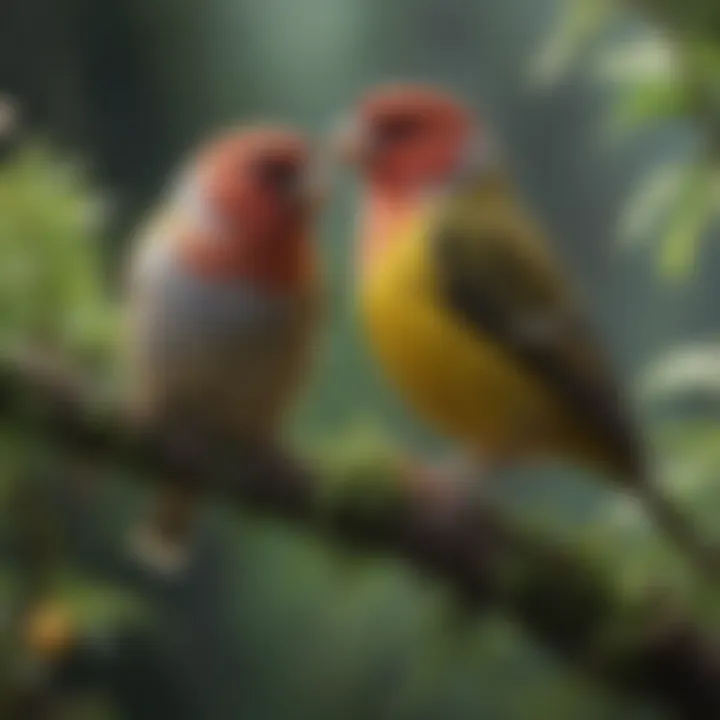
Toys and Playtime Ideas
Choose toys that offer different textures and sounds. Rotate them to maintain interest. Engage your bird daily—they love interactive play.
Training and Tricks
Training sessions not only provide mental challenge but also bonding time. Use treats as incentives to teach tricks, like stepping up onto your finger or basic commands.
Outdoor Activities and Interaction
If appropriate, harness training enables birds to safely enjoy the outdoors while in your company. Supervised outdoor time can significantly enrich their lives.
DIY Projects for Mental Stimulation
Creating simple DIY toys from household items can stimulate both you and your bird. Try crafting foraging opportunities or hang bits of paper for them to shred.
Culmination
The world of exotic pet birds beyond parrots is incredibly diverse and vibrant. By investing time and knowledge into their care, behavior, and health, owners can foster a nurturing and stimulating environment for their feathered friends. This comprehensive journey provides invaluable insights and practical tips, aiming to enhance the experience for all bird enthusiasts.
Intro to Non-Parrot Bird Species
When it comes to the world of pet birds, most conversations tend to orbit around the vibrant and chatty parrots. However, there’s an entire realm of avian life that often goes unnoticed—non-parrot bird species. These fascinating creatures offer a wealth of diversity in colors, temperaments, and care needs. For bird enthusiasts, exploring non-parrot species isn’t merely an academic endeavor; it opens the door to an entirely different experience of aviculture.
Understanding non-parrot birds is important because they come with their own unique attributes that can easily complement a pet owner's lifestyle. For instance, songbirds like canaries and finches fill living spaces with their melodious tunes but often require lower maintenance compared to their more demanding parrot cousins. The stress of keeping a bird can lessen significantly when you choose a species that aligns with your daily routine, environment, and personal preferences.
Many people might not realize that while parrots often demand social interaction and mental stimulation, non-parrot species can thrive in varied environments and often provide delight in more subtle ways.
Benefits and Considerations
- Variety in Care: Each non-parrot species has its unique set of care requirements. For example, doves are typically low-maintenance and adapt well in smaller spaces.
- Social Dynamic: Many birds enjoy company but might not require the same level of social interaction as parrots. This can suit those who love pets but have busy schedules.
- Stunning Aesthetics: Non-parrot birds come in a plethora of shapes, sizes, and colors. From the intricately spotted plumage of a finch to the soft hues of a canary, they offer stunning visual appeal.
- Sound Variations: While parrots are known for their chatter, many non-parrots offer musical calls that can be equally enchanting. The gentle cooing of a dove can create a serene atmosphere while the songs of canaries and finches can be uplifting.
Engaging with non-parrot bird species also requires one to dive deep into their behaviors, social structures, and even their dietary considerations. For instance, learning how to properly care for their unique health needs can enhance both the pet's quality of life and the bond you share. As you inch along the journey of exploring non-parrot species, be ready to enjoy a broader spectrum of avian companionship.
Ultimately, delving into this area enriches your understanding of what it means to be a responsible bird owner. By shedding light on these often-ignored members of the bird kingdom, this article aspires to illuminate the rich tapestry of aviculture beyond just the charming parrot.
Understanding the Appeal of Non-Parrot Birds
Diving into the realm of non-parrot birds opens a treasure trove of fascinating companions, all waiting to add some plumage to your life. The appeal of these birds extends well beyond their vivid colors or melodious songs. It's about embracing the diversity that nature offers and understanding how these creatures can fit seamlessly into our homes and hearts. In this exploration, we'll unpack the nuances that make non-parrot birds such irresistible companions.
A Diverse Range of Choices
When it comes to filling your nest with feathered friends, the variety of non-parrot birds available can be quite impressive. Each species brings its own flavor to the mix. From the brightly colored canaries with their cheerful tunes to the charming finches that flit about with grace, there’s a whole world to explore. Here’s a quick look at some choices you may consider:
- Canaries - Known for their singing abilities, new owners often gravitate towards them due to their pleasing sounds.
- Finches - These lively birds are often seen in pairs or small flocks, making them social and delightful additions.
- Doves - Recognized for their gentle demeanor, doves can be both serene companions and symbols of peace.
- Lovebirds - Their playful nature and vibrant interactions make them a favorite among those looking for an engaging pet.
- Budgerigars - Small yet full of personality, they are often touted as one of the best birds for beginners.
The vast options allow potential bird owners to find a species that not only fits their personal taste but also aligns with their lifestyle.
Variety of Sizes and Temperaments
One of the most compelling reasons to consider non-parrot birds is their varied size and temperament profiles. Not every bird demands the same level of care or interaction, making it accessible for all kinds of families.
For instance, canaries tend to be on the smaller side and can be a bit shy, making them suitable for quieter households. On the other hand, lovebirds, which pack quite the punch in personality despite their size, thrive on interaction and playtime. Here’s how different birds can meet various needs:
- Small Birds (like finches or canaries)
Ideal for those who appreciate charm in a compact package and prefer less demanding companionship. - Medium Birds (like lovebirds)
Require more interaction and engagement but offer entertaining antics in return. - Larger Birds (like doves)
Often need more space and social opportunities, reflecting the lifestyles of more experienced bird owners.
The range of sizes means you can find the right fit for your living arrangement and time commitment. This aspect eliminates the cumbersome idea of a one-size-fits-all when it involves choosing the right winged companion.
"Selecting the right pet bird is not just about species; it’s also about understanding how they’ll fit into your life."
Embracing non-parrot birds involves acknowledging their distinctive traits and how these creatures can enrich our lives. By understanding their needs and temperaments, you’re geared up for a rewarding journey in avian companionship.
Popular Non-Parrot Bird Species
When it comes to pet birds, many immediately think of the lively and colorful parrots, but there is a wide array of fascinating non-parrot species that can enrich our lives. Understanding these popular non-parrot bird species can not only provide potential bird owners with more options but also deepen appreciation for the variety of personalities and characteristics offered by these feathered companions. In this section, we delve into notable species, their unique care needs, and their behavioral traits that make them engaging companions.
Canaries
History and Origin
Canaries hold a special place in avian history. Native to the Canary Islands, these small, cheerful birds were originally bred for their beautiful songs. Their cheerful singing made them a favorite among bird enthusiasts and bred them mainly for entertainment. These birds symbolize hope and joy, serving as reminders that beauty can be found in the simplest of things. The evolutionary journey of canaries showcases their adaptability, making them popular for home cockpits of countless families.
Care Requirements
When it comes to caring for canaries, ensuring they have a suitable habitat is vital. They thrive in spacious cages with natural light and a variety of perches to exercise their wings. Furthermore, a balanced diet—consisting of seeds, fruits, and vegetables—is essential for their health. Not to forget, they need regular sunlight, which helps them synthesize vitamin D. This tendency for physical activity tends to make canaries relatively low-maintenance, yet a proper understanding of their environmental needs ensures their singing spirits stay high.
Common Health Issues
Just like any other pet, canaries can also face health problems. Some common ailments include respiratory issues, such as airsac mites and fungal infections, which can arise from poor air quality. Early identification is crucial; hence observing changes in behavior or vocalization can lead to swift interventions. They might not show symptoms until it's quite late, making routine check-ups with avian vets very important. Maintaining a clean environment and providing a nutritious diet can lessen the risk of these health concerns.
Finches
Species Overview
Finches come in an array of species, all known for their vibrant plumage and active nature. The most familiar types include Zebra finches and Society finches. These birds can range from vibrant yellow and orange to bold black and white patterns. Their charm lies in their sociable character, with most finches thriving in pairs or small groups. This makes them an inviting prospect for anyone seeking the joy of lively bird chatter in their home.
Social Behavior
When exploring finches, social behavior is a key aspect. Finches are inherently social creatures, often seen perched together in mixed groups. They engage in communal singing and preening, promoting a strong bond among their flock. This behavior can provide insight for future owners, highlighting the importance of companionship in their lives. Alone, they can become stressed, so having at least two finches can lead to more enriched and happier lives.
Nutritional Needs
A finch's nutritional needs require an attentive approach. Their diet primarily consists of a variety of seeds, but they also enjoy fruits and leafy greens. It's important to ensure a balanced intake, as improper diets can lead to issues like vitamin deficiencies. Additionally, offering calcium-rich foods is key, particularly during breeding seasons when they need extra nutrients. Formulating a well-rounded diet helps prevent health issues associated with poor nutrition.
Doves
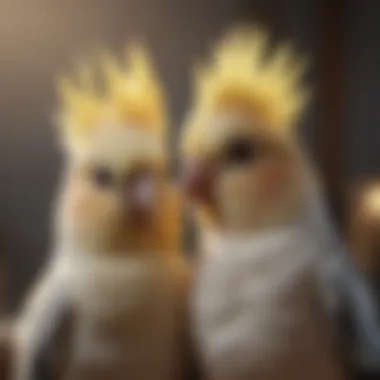
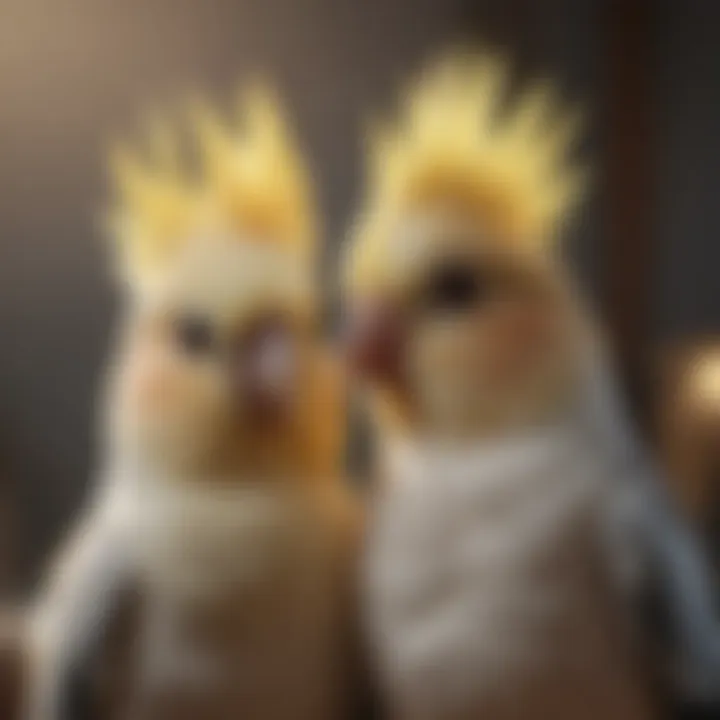
Types of Doves
The four most common types of pet doves include the Ringneck Dove, Love Dove, Diamond Dove, and Mourning Dove. Each presents unique traits and characteristics that can enhance one’s experience as a bird parent. For instance, the Ringneck Dove is lauded for its docile nature and gentle cooing, while the Diamond Dove is smaller and often considered the cutest. This variety allows prospective owners to choose doves that harmonize with their lifestyle and preferences.
Caring for Doves
Caring for doves requires a gentle touch, as they are generally sensitive creatures. Providing a spacious cage and a soft bedding is crucial for their comfort. It's also vital they receive a well-balanced diet that includes seeds, grains, and vegetables. Regular access to fresh water promotes hydration, ensuring they remain in optimal health. Their calm demeanor makes them approachable, thus establishing a bond with them is often quite rewarding.
Understanding Dove Behavior
Understanding the behaviors of doves can deepen appreciation for these birds. Doves express affection through preening and can even coo softly to communicate with their owners. They tend to thrive on routine, responding well to predictable schedules. Noticing changes in their behavior can signal stress or illness, underscoring the need for observant ownership. Careful attention to their needs fosters both a healthy environment and a strong bond.
Lovebirds
Unique Characteristics
Lovebirds are aptly named for their strong pair bonding and affectionate demeanor. This trait makes them distinct and highly valued for companionship, but it can also pose challenges. These small parrots can be quite energetic and playful, bringing lively spirits into homes. Yet, their need for attention and social interaction often requires dedicated time from owners.
Habitat Requirements
Creating a proper habitat is paramount for the happiness of lovebirds. These birds thrive in spacious cages, ideally equipped with climbing opportunities and various toys to stimulate their minds. They also enjoy natural light, so placing them in a bright area is beneficial for their overall well-being. While personalizing their space can create a unique environment, recognizing their need for social connection remains crucial.
Breeding Considerations
For those interested in breeding lovebirds, it's important to consider their behavior. These birds are notoriously discerning when selecting mates, often forming deep bonds. Providing suitable nesting materials and space is essential for successful breeding. However, it’s vital to research the responsibilities associated with breeding. Ensuring the young lovebirds find proper homes and that the parents remain healthy adds an extra layer of commitment.
Budgerigars
General Care Tips
When considering budgerigars, or "budgies," knowing some general care tips proves beneficial. Ensuring they have a balanced diet consisting primarily of seeds, vegetables, and occasional soft foods like cooked rice helps keep them healthy. It's also important to provide ample space for them to exercise their wings, either through varied cage heights or outdoor-time in safe enclosures.
Training and Bonding
Budgerigars are exceptionally trainable, making bonding with these birds a fun endeavor. Start training them early by using positive reinforcement strategies, like offering treats for desired behaviors. Building trust takes time, so patience is essential. Their responsive nature can lead to tricks and even simple speech, further enriching the relationship with their owners.
Common Misconceptions
A common misconception about budgies lies in their vocal capabilities; many believe they only screech. However, if they're engaging and stimulated, budgies can develop a fantastic ability for mimicking sounds and even human speech. Recognizing their potential for companionship goes beyond their size, highlighting just how special these small birds can be.
In summary, exploring popular non-parrot bird species reveals a world of options beyond the typical. By understanding their origins, care needs, and behaviors, potential owners can find the perfect companion to suit their lifestyle and preferences.
Essential Care Practices for Pet Birds
Caring for pet birds requires a unique blend of attention, knowledge, and compassion. Essential care practices ensure these feathered companions thrive in a human environment. Focusing on various aspects such as their living conditions, dietary needs, and health check-ups contributes to their overall well-being. This section sheds light on how proper care can not only enhance the quality of life for birds but also strengthen the bond between them and their owners.
Housing and Environment
The foundation of a healthy life for any bird is its environment. Housing considerations are key to any bird's well-being, and the environment should mimic their natural habitat as closely as possible.
Cage Selection
Selecting the right cage is fundamental. The cage should be spacious enough to allow the bird to spread its wings and move freely. A large cage not only prevents boredom but also encourages exercise, which is vital for physical health. Sturdy cages made with non-toxic materials are usually a safe bet, while horizontal bars allow for climbing. However, it's crucial to be mindful of the bar spacing to prevent the bird from getting stuck, which can be injurious. A well-chosen cage isn’t merely a home; it’s a space for exploration and growth.
Temperature and Humidity
Temperature and humidity play significant roles in the health of pet birds. Birds are generally sensitive to extreme temperatures, both hot and cold. A comfortable room temperature, ideally between 65°F to 75°F, helps them remain stress-free. Moreover, maintaining appropriate humidity levels is equally important. Birds thrive in environments with humidity levels around 40-60%. Too much dryness can lead to feather issues, while excessive humidity can foster the growth of mold, leading to respiratory problems.
Air Quality Control
Good air quality is indispensable for pet birds. Poor air quality can result in a number of health issues, like respiratory problems and stress. It’s essential to ensure proper ventilation in the bird’s living space. Using air purifiers, keeping the cage clean, and avoiding exposure to cigarette smoke or toxic fumes are effective ways to maintain clean air. Remember, a healthy environment supports a happy bird.
Nutrition and Diet
Bird diet is another cornerstone of their care. What they eat impacts not only their physical health but their mood and behavior as well.
Balanced Diet Essentials
A balanced diet is crucial for a bird's longevity. A mix of seeds, pellets, fresh fruits, and vegetables is typically recommended. Pellets designed for the bird's specific species are particularly beneficial due to their comprehensive nutrient profile. Having a variety prevents boredom and encourages healthy eating habits, leading to a vibrant and active pet. Not all birds have the same dietary needs, so knowing the specifics about your bird type is essential.
Common Foods to Avoid
Awareness of hazardous foods can save pet birds from serious health issues. Items like avocado, chocolate, caffeine, and onion are notoriously toxic to birds. Knowing what to avoid means protecting your feathered friend from unnecessary health risks. Even human snacks, while appealing, often do not meet the nutritional needs of birds.
Supplements and Treats
Sometimes, even the best diets might need a little extra to keep birds healthy. Supplements can be a good addition to their diet, particularly calcium and omega fatty acids, helping with feather quality and overall vitality. As for treats, moderation is key. Choosing appropriate treats ensures they enjoy something special while still benefiting from their nutrient-rich diet. Too many treats can hinder a bird's appetite for more wholesome food, leading to potential nutritional gaps.
Health and Hygiene
Keeping your bird healthy goes hand in hand with understanding its hygiene needs and the importance of routine check-ups.
Regular Vet Check-ups
When it comes to avian health, regular vet visits can't be stressed enough. Birds often hide illnesses until they become severe, making preventative check-ups vital. A veterinarian familiar with avian species can help monitor general health, ensuring everything from feathers to beaks remains in top shape. The investment in preventive care pays off in the long run, typically resulting in longer, healthier lives.
Grooming Needs
Grooming is not just a luxury; it’s a fundamental need for pet birds. Regularly trimming beaks and nails, along with providing opportunities for baths, keeps birds clean and comfortable. Each species might have specific grooming needs; for instance, some require more frequent beak trimmings than others. A little grooming goes a long way in promoting both hygiene and comfort.
Signs of Illness
Being observant can be a life saver. Understanding signs of illness—increased lethargy, changes in appetite, or unusual droppings—can prompt immediate action. Early detection is key to successful treatment, so monitoring changes in behavior and appearance should be part of every bird owner's routine. Knowledge is power when it comes to keeping your feathered friends healthy.
Behavioral Insights
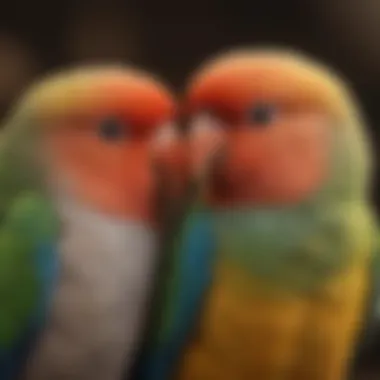
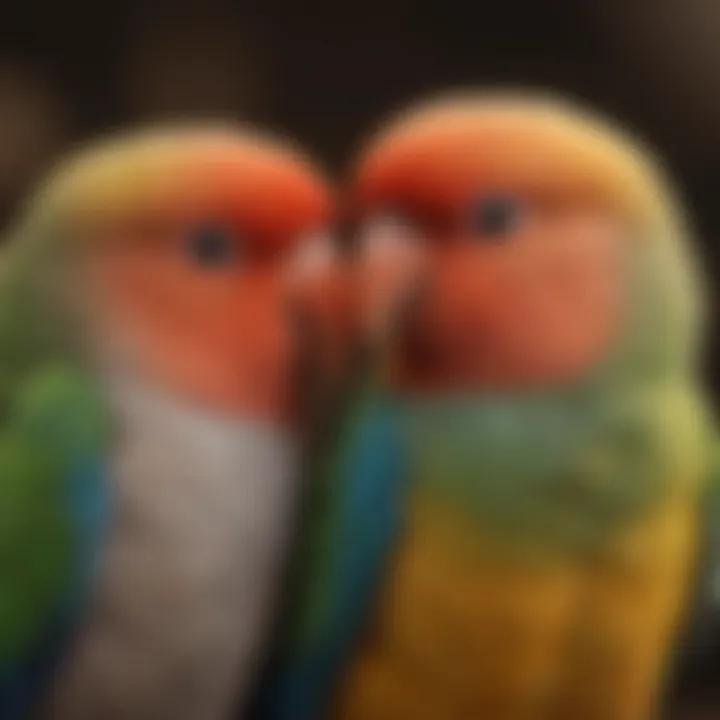
Understanding behavioral insights into non-parrot pet birds forms a crucial element in ensuring a satisfying companionship. Observing bird behavior helps owners comprehend the emotional and physical wellbeing of their feathered friends. Recognizing stress signals or understanding playful behavior can lead to a healthier relationship, reducing the likelihood of behavioral issues. Knowledge of how a bird thinks and interacts will equip the owner to provide a more enriching environment, ultimately improving the quality of life for both the bird and the human.
Understanding Body Language
The body language of birds speaks volumes. Contrarily to what one might believe, these animals do not just caw or chirp but communicate through an array of movements and postures. For instance, if a bird starts puffing its feathers, it could signal either contentment or a sign of distress, depending on the context. Likewise, a head bob can frequently indicate excitement or an invitation to play.
One effective approach is to watch your bird interact with its surroundings. A bird that hangs its head low might feel threatened; meanwhile, a mostly upright stance often indicates the bird is feeling confident. Another telltale sign is the tail position. A bird with a wagging tail indicating joyful playfulness is a sight to behold, whereas a bird that has its tail feathers fluffed could be trying to make itself appear bigger when feeling cornered.
Social Interactions and Play
Birds are incredibly social creatures. Their natural inclination is to live in flocks, and understanding this can steer owners in providing better environments that mimic these social structures. Engaging in activities that stimulate social behaviors is necessary for any bird, regardless of species. Interactive toys, perches that encourage movement, or even training sessions can play a huge role in keeping a bird's mind engaged.
Furthermore, fostering routine social interactions will also help. For example, spending quiet time together, talking or whistling a tune can enrich the bond significantly. Owners should also consider having another bird breed in the household, as having a companion can keep them from feeling lonely and can reduce stress-related behaviors that arise from boredom.
Addressing Behavioral Issues
Sometimes, even the most well-cared-for birds exhibit behavioral issues. Factors such as stress, lack of stimulation, or health problems might ignite them. When a bird shows signs of excessive screaming, feather plucking, or aggressive behavior, it’s time for the owner to put on their detective hat. Owners should ask the following questions:
- Is the bird's environment too small or poorly set up?
- Are there enough opportunities for stimulation and play?
- Could there be hormonal changes affecting behavior?
Solving these issues requires patience and observation. Gradually introducing changes in environment or routine can make a significant difference. For example, adding foraging toys can channel excess energy towards a beneficial activity. Moreover, consistency in training and a clear set of boundaries helps a bird to understand expectations, oftentimes diffusing unwanted behaviors.
"A little knowledge about avian behavior can go a long way in building a rewarding relationship with your pet bird."
Bird owners need to remain vigilant yet compassionate towards their beloved companions. In doing so, they'll create a nurturing environment where their exotic pet can thrive both physically and emotionally.
Creating an Enriching Environment
Creating an enriching environment for non-parrot pet birds is not just a luxury; it is a fundamental necessity that significantly influences their well-being. Birds, like many other pets, require stimulation for their physical and mental health. When thinking about your bird’s habitat, it’s vital to remember that boredom can lead to destructive behavior and emotional distress. An enriched environment allows them to thrive and express their natural behaviors, promoting a happy, healthy pet.
Toys and Activities for Mental Stimulation
One of the cornerstones of enriching your bird’s environment is providing various toys and activities that stimulate their minds. Birds are naturally curious creatures, and they love to explore. Toys that require solving puzzles, like foraging toys, can keep them occupied and engaged. Additionally, swings, bells, and mirrors can offer a mix of entertainment and exercise.
Consider rotating toys frequently, as introducing new ones can reignite interest in their surroundings. Look for materials that are safe and non-toxic; wood, natural fibers, and untreated materials can be particularly great. Here are some ideas for mental stimulation:
- Foraging Toys: Hide treats in toys that they have to dig or pull apart to find.
- Interactive Toys: Look for toys that respond to your bird’s actions, like making noise or moving.
- DIY Options: You can craft toys from safe household items, like paper towel rolls filled with shredded paper or twine.
Equipping their space with such toys not only keeps them busy but also helps in developing problem-solving skills, necessary for their cognitive development.
Socializing with Your Bird
Birds are inherently social animals. If they have no interaction, they can become lonely and anxious. Regularly spending time with your bird can foster a bond that’s incredibly rewarding for both of you. During these moments, speak softly and handle them gently to help build trust.
Incorporate socialization into daily routines. Just like how a dog enjoys a walk or a cat enjoys sitting on the window sill, your bird will value quality time outside their cage. Consider these strategies for building social connection:
- Scheduled Playtime: Set aside dedicated times each day for out-of-cage play.
- Training Sessions: Use positive reinforcement training. This can also reinforce your bond.
- Shared Experiences: Take your bird with you, if safe, while doing chores or relaxing. Let them observe and be part of the family dynamic.
Safe Outdoor Experiences
Outdoor adventures can enhance your bird's quality of life, exposing them to natural stimuli, fresh air, and the sun. However, safety is key. If you plan to take your bird outside, make sure to consider a few things. A secure, travel-friendly bird carrier or harness is crucial to ensure their safety while allowing them to enjoy the great outdoors.
Before heading outside, familiarize your bird with the carrier or harness. This can make the experience less stressful. Remember these tips:
- Supervised Outings: Always supervise your bird when they’re outside.
- Avoid High-Temperature Days: Birds can easily overheat; early morning or late afternoon is often ideal.
- Enrichment Elements: Bring along toys or treats to create a comfortable, familiar atmosphere during outdoor time.
Taking the proper precautions can allow your bird to enjoy nature while ensuring they remain safe and secure. With that in mind, making an effort to create an enriching environment can lead to a long and fulfilling companionship.
Rescue and Adoption Considerations
Adopting a pet bird brings immeasurable joy and companionship, yet the emphasis on rescue often can’t be overstated. Many bird species, unfortunately, find themselves in need of homes. Fostering a rescue bird not only provides a much-needed safe haven for a creature in distress but also enriches your life in unexpected ways. The particulars of rescue and adoption play a pivotal role in shaping the narrative of non-parrot bird species. Thus, the motivations behind adopting rather than purchasing from stores deserve thoughtful attention.
Benefits of Adoption
When considering a pet bird, the benefits of going the rescue route are profound. For one, it provides you a chance to save a life, adopting a bird that otherwise may face uncertainty or neglect in their previous situation. Additionally, many rescued birds have already undergone some degree of socialization which can sometimes ease the transition into your home. Here are some key benefits to adoption:
- Diverse Options: Rescues often house a wide range of species. Whether you're seeking a finch, canary, or dove, many rescues operate on a spectrum of avian species, presenting opportunities to find the right match for your living space and lifestyle.
- Potential for Established Personalities: Often, birds in a rescue setting have developed specific personalities and social behaviors, allowing you to find a companion who suits your preference more closely than from a pet store.
- Financial Savings: Adoption fees for birds are generally lower than purchasing from retail outlets. In addition, these fees often include initial vaccinations and sometimes even behavioral training, which might round out financial considerations.
- Healthy Start: Many reputable rescues conduct health checks on their birds and often ensure they are treated for any immediate health concerns, thereby minimizing future vet expenses.
Adopting also allows you to join a community of bird lovers. Many rescue operations have extensive networks. Resources such as local Facebook groups or Reddit communities can connect you with tips and other bird enthusiasts.
Finding a Reputable Rescue
Finding a trustworthy bird rescue is paramount for making sure your transition into bird parenthood is a smooth one. Not every rescue operation is created equal. Some may lack transparency or adequate resources, making it crucial to do your research before proceeding. Here are some points to keep in mind:
- Research Online Reviews and Ratings: Websites like Facebook and Reddit have numerous groups where bird adopters share their experiences. Use this information to gauge which rescues have high reputations.
- Visit In Person: If possible, take a trip to the rescue facility. A legitimate rescue will be open about their animal husbandry practices, provide a clean environment, and have knowledgeable staff that can answer your questions. Look for freedom of movement for the birds and interaction with people – a sign they are well-adjusted.
- Inquire About Their Policies: Understand the adoption process, including how they assess bird matches, their return policy, and any post-adoption support or resources they offer.
- Ask about Health and Behavioral History: Inquire whether the birds have received veterinary care, any known behavioral issues, and what socialization training they have received.
By ensuring you are adopting from a reputable source, you are setting both yourself and your new feathered friend up for success. The adoption process, while sometimes daunting, can be filled with rewarding moments that lead to a fruitful partnership with your new avian companion.
Finale: Choosing the Right Companion Bird
Selecting the perfect companion bird is a significant decision that requires careful deliberation. Throughout this article, we have uncovered the vast array of non-parrot pet bird species, their unique traits, and the care they demand. Understanding your needs and those of the bird is paramount in ensuring both are well-suited and happy in a shared environment.
Birds, despite their small size, can have quite a large presence in our homes. They bring joy, companionship, and a bit of avian charm to daily life. Furthermore, choosing the right bird should lead to a mutually beneficial relationship, with minimal stress for both you and your feathered friend.
Reflecting on Your Lifestyle
When considering which bird to bring into your home, it's crucial to reflect on your own lifestyle. Different birds have varied needs concerning space, noise level, and social interaction. For instance, a lively cockatiel may thrive on chatter and companionship, while a more solitary finch may prefer peace and quiet.
A few questions to ponder include:
- Do you have enough time to devote to the bird's socialization?
- Can you provide the appropriate space for the species you're interested in?
- What is your tolerance for noise?
Understanding these factors can help you make an informed choice. A bird that fits well into your lifestyle will surely flourish, promoting a harmonious environment where both you and your pet can thrive.
Long-term Commitment
Bringing a bird into your life is not just a short-term decision; it’s a long-term commitment. Birds, especially those we tend to keep as pets, can have lifespans that span decades. For example, canaries can live around 10 years, while larger species, like African Grey parrots, can live for over 50 years. This longevity means you need to plan for the long haul. You should ask yourself:
- Are you ready to devote years to nurturing and caring for this companion?
- What arrangement will you make if your life situation changes?
Consider not just the immediate joy a bird may bring but the future as well. Preparing for changes such as relocation or lifestyle shifts is essential. Building that level of commitment will enhance both your life and the life of your feathered friend, providing stability and a loving home for them as they grow old.
It's not just about having a pet; it's about welcoming a new family member into your life.















